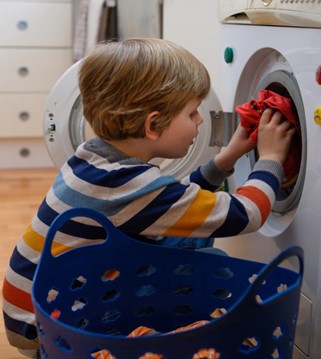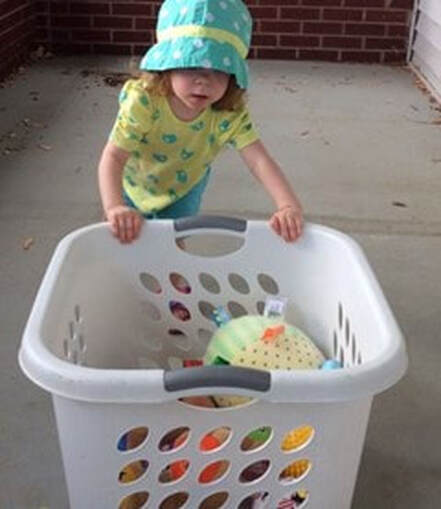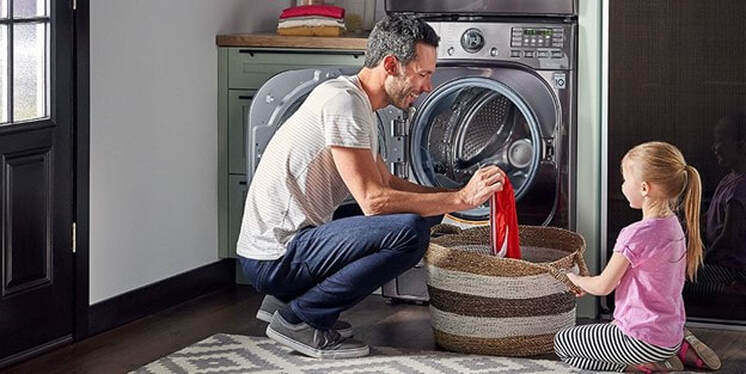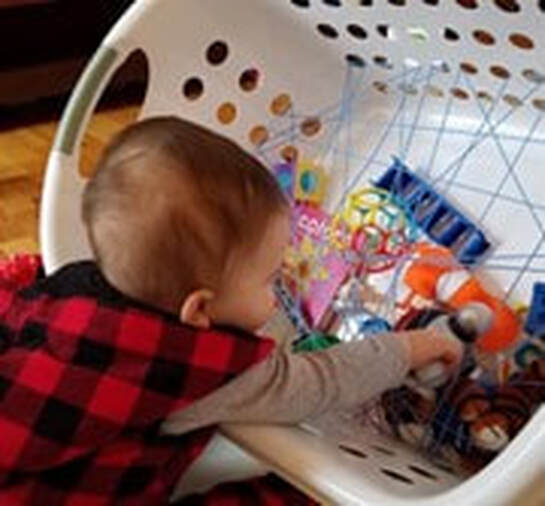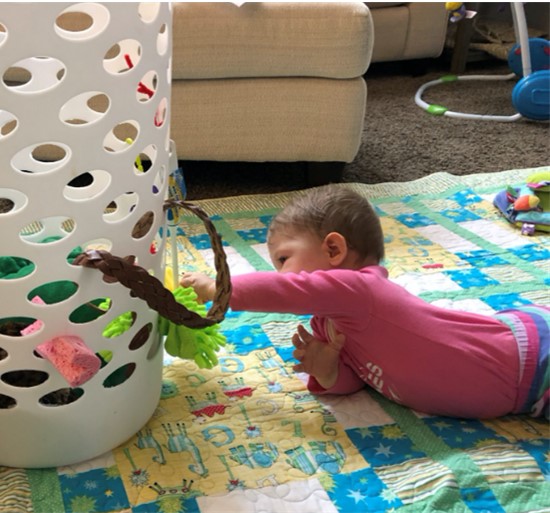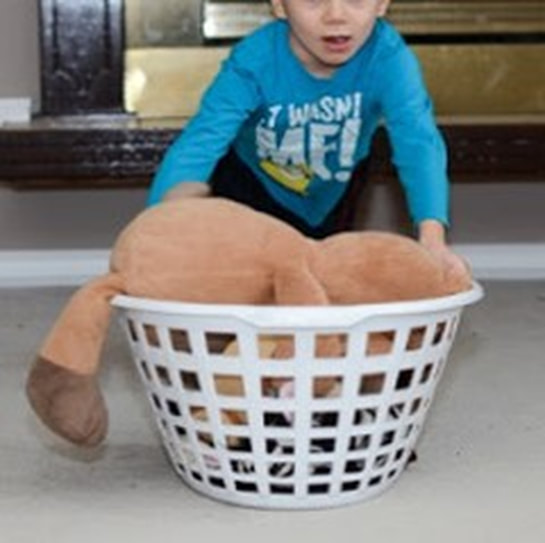You don’t need to complete the entire laundry routine with your child because that could take hours. You can choose an activity or more within each step that correlates with your child’s age, developmental level, and interests. And, while you’re waiting for the clothes in the washer or dryer, try the other fun ways you can use a laundry basket for play time.
| |
Duration
This activity may range from 15 to 60 minutes depending on your child’s interest level and ability.
Materials Required
|
Activity Steps
For a child who is visually impaired, modern appliances can be scary. They make funny noises, and they feel cold and metallic to the touch. When introducing something unfamiliar to your child, always use hand-under-hand. With this strategy you invite your child to put their hand(s) on top of yours as you explore something new.
During this laundry activity, instead of pulling your child’s hands to the washing machine, you can touch the washer and ask your child to “hop on” or put their hands on top of yours as you open the lid, touch a dial, or drop a sock in the bin. It is important that your child never feels forced to enter the laundry room if they are sensitive to sounds or hesitant to go in. Allow them to listen and participate from a distance as you describe to them what you are doing. |
Washing the Clothes
|
|
4. What is the route you take to your laundry room? As you travel there together, describe to your child some of the landmarks and clues along your route. Landmarks and clues are things which help your child recognize where they are in space. Landmarks are permanent, fixed, and easily recognizable to your child. An example of a landmark could be the shag carpet located in your family room or the refrigerator that hums in your kitchen. A clue, on the other hand, is not a permanent fixture in your home but is very helpful when available. An example of a clue is the delicious smell coming from your kitchen when you cook dinner or bake cookies. The smell of cooking can help guide your child towards the kitchen but may only offer a clue during mealtimes. As you’re getting closer to your laundry room, a clue might be the sound of the dryer running. You might say, “I hear the dryer running, and hmm, I love the smell of those lavender dryer sheets.”
5. When you arrive at the washing machine, invite your child to reach out and touch the smooth, cold surface. Talk to your child about whether the washer is on or off. You can knock or tap on the machine and listen for the metallic sounds. Invite your child to touch a button or dial and explain what they are for. 6. Depending on your child’s interest and age, you can introduce sorting. If your child can see colors, they can sort by color. If not, they can sort by weight or type of fabric. For example, “These socks are black and go in the dark pile. Daddy’s t-shirt is white. It goes in the white pile. Mommy’s leggings are stretchy. We have to wash them with our hands in the sink.” 7. Invite your child to help open the lid to the washer or pull the door open on a front-loader. Is there anything in the washing machine? You could say, “The washing machine is empty. Let’s put clothes inside it so it’s full.” Using hand-under-hand, invite your child to touch the inside of the washing machine and say, “The inside of the machine is shiny! And it’s full of holes!” Your child could also use a wooden spoon to tap the inside of the machine. 8. Now, it is time to load the washing machine. Talk to your child about your laundry basket and how full it is of dirty clothes. “We are going to make the basket empty and the washing machine full instead!” 9. Together start to pull the laundry from the basket and put each piece in the washer. Talk about the concepts of in and out. Label the articles of clothing as you drop them in the machine. If you have a front-loading washer, the child could sit or stand between the basket and the washer for easy access. If you have a top-loading washer, pick your child up after they have pulled the piece of clothing out of the basket and help them put it in the washer. If your child has physical challenges, they can still participate. You can bring each piece of clothing to the child to look at or explore with hands, arms, or feet. 10. Talk to your child about what kind of laundry soap you use and smell it together. Remember, laundry soap or pods should always be dispensed with adult supervision. 11. Together, shut the lid to the washer. Continue narrating the routine as you turn on the washer. You could say, “I’m going to turn on the washer. Can you help me push the buttons? Now, let’s listen for the sound of the water running. The washing machine is starting to hum!” 12. Now, you can say, “Our laundry basket is empty! Let’s go play a game/read a book/take a nap while we’re waiting for the washing machine to clean our clothes. The dial on the machine says it will take 45 minutes.” |
Drying the Clothes
1. Listen for the washer to stop. Maybe you set a timer so when the timer goes off, you could say, “Oh, our clothes are clean. Let’s go put them in the dryer.” You’ll take the same travel route, so talk about the landmarks and clues along the way. “It’s quiet in the laundry room because the washing machine isn’t spinning anymore.”
2. When you arrive, narrate what you see and hear. Describe how you’re opening the washing machine. You could say, “The washing machine is full of wet clothes! We need to take them out of the washing machine and put them in the dryer.” Your child might be able to help you transfer the clothes from one machine to the other. As your child helps you fill the dryer, you could say, “Your shirt is wet. It feels heavy. Put it in the dryer for me while I pull out another wet shirt.” 3. If you use them, allow your child to touch and smell the dryer sheet. “The dryer sheet smells like Grandma’s garden! And it will make our clothes softer.” After adding the dryer sheet, invite your child to shut the dryer door. Help your child feel the knobs and dials on the dryer. Together, turn on the dryer. Talk about how long it will take for your clothes to dry – 30 minutes or longer? As the dryer begins to run, what do you hear? Sometimes, it is just a gentle hum. Other times you might say, “What’s making a lot of noise in there? Oh-oh, Daddy left his car keys in his jeans! We need to stop the dryer and pull out his car keys.” Does the dryer feel warm yet? 4. While you’re waiting for the clothes to dry, go play a game with your empty laundry basket! |
Folding the Clothes
1. When the dryer stops, follow the same travel route with your child back to your laundry area and narrate how you are putting the dry clothes in your laundry basket. Again, this is another opportunity to use words like “in/out,” “open/close,” “wet/dry,” “clean/dirty,” “warm/cold,” and “heavy/light.” Label the clothing as you remove it from the dryer. “Here’s your soft red t-shirt! Can you hold this fuzzy sock while I find the other one?”
2. Every routine has a beginning, middle, and end. Folding clean clothes and putting them away is the end of the laundry routine, and it teaches children where their clothes belong so, one day, they will be able to find them on their own and get dressed. 3. Travel to wherever you fold laundry. Talk about the route. Your child could push the laundry basket (as a pre-cane), with a few of their clean clothes in it. The room where you fold laundry might be a different place than where the washer and dryer are. Maybe you fold laundry on your kitchen counter or on your bed. Talk about the landmarks that identify the new room. What is the room called? What do you do there? Are there any clues like sounds or smells that would identify this room? 4. Invite your child to help fold simple things like towels, washcloths, or socks. Talk about the process. “We are finding two socks that are the same and putting them together!” When the clothes are matched and folded, talk about where the clean clothes go. “Your socks go in your dresser in your bedroom. Let’s go to your bedroom and put your socks in the drawer. Then we need to hang Mommy’s shirt on a hanger in her closet.” 5. After you’ve put your clothes away, your laundry basket is empty again. Return your laundry basket to the laundry room or wherever you store it. You could say, “We’re all done with laundry for today. We washed, dried, and folded all our clothes.” |
Tips
|
Extension Activities
A laundry basket is a versatile learning tool, and it’s fun!
|
And More!
|

